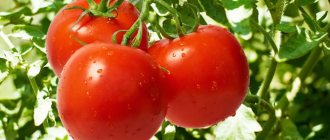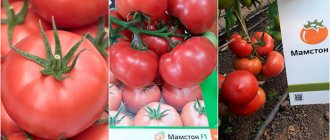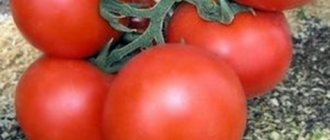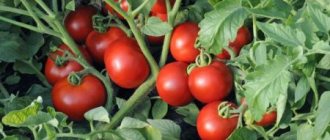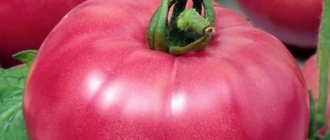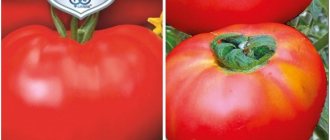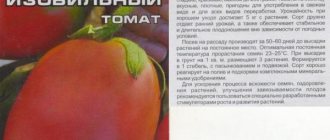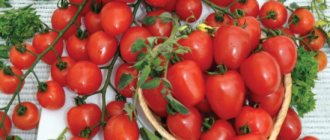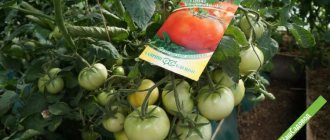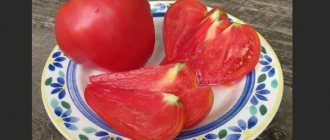Description and characteristics of Betta tomato
The bushes are small and compact. There are few leaves on the bushes. Betta belongs to the category of determinate varieties of standard-type tomatoes. The height of the bushes is small. In adulthood, the maximum height of a tomato bush, according to the description, does not exceed 0.5 m.
For a short plant, Betta produces decent yields of small fruits. The average size of tomatoes is 50 g . Some specimens may weigh more - 80-100 g . The color of the tomato pulp and skin is bright red.
The fruits of the variety are small and weigh about 50 grams
The pulp is juicy, with good taste, and can be used for processing into juices, ketchups, and smoothies. In simple cutting and in fresh salads, Betta performed well as well as in whole-fruit canning.
The fruits, although not large, are quite marketable. Their shape is round, slightly flattened at the top and bottom. Small tomatoes look good in jars for whole-fruit canning. The fruits are collected in clusters of 4-6 pieces.
Growing this variety in a greenhouse is unprofitable . The bushes are low-growing, so the greenhouse space will not be used rationally. Although the yield of this small plant is high - 2 kg / bush .
By planting 6 plants per 1 m2, you can get up to 12 kg of tomatoes per unit area. An important characteristic of tomatoes is the speed of ripening. The Betta tomato has this value at its best. The first tomatoes ripen after 85 days.
Features of the variety
Breeders from Poland gave a luxury tomato variety to gardeners. This low-growing plant reaches a height of only fifty centimeters. On its moderately leafy stems, after eighty-five days, fruits ripen. The characteristics of tomatoes are excellent:
- flat-round shape with slight ribbing at the stalk;
- weight up to fifty grams;
- small number of seeds;
- smooth skin without cracking;
- dense and juicy pulp;
- sweetish taste with slightly perceptible sourness;
- bright red color.
And the yield of the early-ripening tomato variety is high - up to two kilograms per bush, because up to six rich red tomatoes ripen on one bunch.
Growing seedlings
In order to plant tomatoes in the garden with the arrival of spring, you should grow seedlings. To breed a hybrid, seed material purchased from specialized stores is used. Please note that this variety must be grown separately from other nightshade crops.
This is due to the fact that cross-pollination negatively affects tomato yields.
():
You can plant at least 100 different varieties of tomato next to each other, if you do not plan to collect seeds from them for further sowing. This will not affect their current yield in any way.
It is allowed to use purchased seeds without additional disinfection. The seed sold in the store has already been processed.
Be sure to use drugs that stimulate active seed germination. You should not keep them in solution for more than 5-6 hours.
To grow seedlings, use a soil mixture consisting of equal parts of turf, peat and humus. The seed is sown in early spring. The optimal time for gardening is March. Use large wooden containers (when planting seeds in a common container) or plastic disposable cups.
Please note that the container must have sufficiently high sides - at least 15 cm.
Technology
Tomatoes need to be properly cared for
Make grooves in the soil for the seeds. Make sure that their depth is not more than 2-2.5 cm. Try to maintain the same spacing between seeds (1.5 cm). Water them with settled warm water. Fill with soil and then cover with peat.
Containers with seed material are covered with glass or polyethylene. This will help create a greenhouse effect, which will stimulate seed growth. The cover should be removed after the first shoots appear. Place the container in a dark place and water the crops no more than once every 7 days.
():
The greenhouse effect is the conversion of the light energy of the sun into thermal energy inside a greenhouse or greenhouse due to heating of the soil and internal structures and its accumulation there. The crops are covered with film not to create a greenhouse effect, but to retain moisture while the seeds germinate. Germination can be done without light, the main thing is that it is warm.
To plant seedlings, use disposable containers. Peat is suitable as a soil: you can replant the grown shoots into the garden bed with it.
():
High peat is suitable in its pure form only for growing seedlings. This is the name given to plants from germination to sprouting. The duration of growing seedlings is short - only 15-20 days. After picking, the plants are no longer called seedlings, but seedlings. They were SETTED IN different containers. For seedlings, you need more nutritious soil than peat.
Description of the Artist tomato and rules for growing a hybrid variety
Tomato Artist f1 was registered in the Russian Seed Registry in 2003. Farmers can purchase its seeds directly from the manufacturer (agronomic) or in retail stores or “Aelita”). The variety is hybrid, but shows high yields when growing tomatoes in a greenhouse. The tomato is used for canning whole fruits and creating salads. The artist tolerates transportation well.
Briefly about the Artist tomato
The characteristics and description of the variety are as follows:
- The ripening time of a tomato from planting seeds to receiving the first fruits ranges from 100 to 115 days.
- The bush of the plant grows up to 140-150 cm. It grows only on closed soils (greenhouses, film and glass greenhouses).
- The leaves of the plant are medium-sized, growing upward, at a certain angle to the trunk.
- Tomato bushes are quite compact. Their formation is carried out in 1-2 trunks.
- The first brush appears after the development of the 9th or 10th leaf. Then the ovaries begin to form every 3-4 leaves.
- Most often, 7-8 brushes develop on a plant. After they appear, it is recommended to remove the top of the stem.
- One inflorescence of Artist produces 5-8 fruits. The tomatoes are the same size.
- The weight of each fruit varies in the range of 0.14-0.15 g. Some farmers who planted this variety in the ground in a well-heated greenhouse claim that under such conditions the same fruits are obtained, each weighing up to 0.2 kg.
- The tomato is round in shape and sometimes has small ridges. Unripe fruits are colored in greenish shades, and a ripe tomato is scarlet in color, without a green spot near the stalk. The pulp has a dense consistency.
The hybrid resists various diseases well. For example, the variety is resistant to gray rot of the stem, tobacco mosaic virus, and root-knot nematode. The variety is not susceptible to brown spot and fusarium wilt.
Reviews from gardeners who planted tomato varieties of the described variety show that in favorable conditions, 9-10 clusters can form on the plant, which significantly increases the yield of each bush. Therefore, farmers give positive characteristics to this tomato variety.
From 1 m² of bed you get from 20 to 30 kg of fruit. The harvest can be harvested until the end of the season. It all depends on the type and capabilities of the greenhouse. Fruits that have not yet ripened are placed in boxes and transferred to a cold place. There they ripen successfully. They can be stored for about 30 days.
How to grow the described variety?
A plant of this type can bear fruit well when the light is insufficient for other tomatoes. As one farmer says:
“I’ve been growing the Artist tomato for several years now. I tried to grow bushes in the darkened corners of the greenhouse - for comparison, I left several beds in normal lighting. The result was surprising - all the bushes had almost the same number of brushes.”
You need to know that Artist, although intended for growing in warm, protected soil, can easily tolerate temperature stress. This variety also produces crops in cold summers with temperature changes. He is not afraid of heat, since it has practically no effect on the development of fruits.
It is necessary to loosen the soil in time and remove weeds. Water the tomatoes with warm water. The plant should not be allowed to remain without fertilizing. At first, it is recommended to use more nitrogenous fertilizing, and after the ovaries appear, they switch to the use of potassium and phosphorus fertilizers. If they are not available, you can use manure, ash or peat.
When bushes are attacked by various pests, for example, aphids or the Colorado potato beetle, various caterpillars, chemicals and folk remedies are used to combat insects.
How to grow tomatoes?
In late May - early June, seedlings are transferred to the ground. At this point, the tomatoes are about a month old from the moment the seeds germinate. The main condition is that the soil must be warmed up during the day and at night to at least 15 C. The best time for replanting is early morning or evening, the weather is better damp. Choose the sunniest place on the site.
Landing
Planting of seedlings occurs at the beginning of May, when the age of the plant reaches 30-35 days. In open ground, a bush density of 50x30 cm is allowed.
- They are not planted very deep because the roots are quite short.
- Ash and complex fertilizers are added to the holes as an antiseptic.
- Water generously with warm, settled water.
- The roots and soil also need to be squeezed thoroughly with your hands.
Care
Always water at the root, so as not to provoke flying of inflorescences and disease. In dry weather, the amount and frequency of watering is increased; in wet weather, on the contrary, during flowering it is also reduced.
Thanks to the low and strong trunk, they do not require staking or pinching. Lack of water affects the leaves as they fall and turn yellow. Excess, on the contrary, promotes fungal diseases and rotting of the root system.
In general, care is the simplest:
- watering once every 5-7 days;
- fertilizer 3 times per season;
- loosening;
- manual weeding.
Mulching also promotes better moisture and ventilation of the root system. It is recommended to mulch with organic matter (dry grass, shavings, husks, sawdust, straw) or inorganic materials (perforated bag). A protective layer of mulch fights pests and weeds, prevents overheating and compaction.
Due to the high density of beds, the Betta variety is less prone to weed growth. Weeding is always carried out in the early stages of weed development, so as not to accidentally damage the crop itself. The best prevention is the right choice of mulch, which will prevent weeds from pollinating. Proper compost, which should not contain freshly picked weeds, also helps.
It responds well to additional fertilization. For example, you can take 30 g of superphosphate or potassium salt per bucket of water and water it 10-12 days after planting in the ground. To stimulate the ovaries, spray boric acid (10 g) onto a bucket of water.
Description of types and varieties of garden daisies, planting, cultivation and care
Features of cultivation and possible difficulties
The agricultural technology of tomatoes does not cause any particular problems, but you can make the growing process more comfortable and easier.
- The method of direct sowing of seeds is more suitable for the southern regions.
- It is not recommended to place it together with other varieties of tomatoes, as this can lead to cross-pollination and possibly reduce yield.
- To protect young plants from cold and wind, temporary shelters are additionally installed.
Diseases and pests
It has genetic immunity to a number of nightshade infections. Extremely rare, but still possible cases of the disease:
- top rot;
- TMV (tobacco mosaic virus);
- Alternaria (dry spotting).
The main threat is the attack of parasites on the tomato beds, such as:
- Colorado potato beetles;
- spider mite;
- thrips.
Preventive measures will help avoid their occurrence:
- weeding;
- hilling;
- manual collection of larvae;
- treatment with safe insecticides.
General information
The bushes of these tomatoes, according to the description, are compact and low; they do not produce many leaves. Betta tomatoes do not grow higher than half a meter.
The fruits of the variety are rich red in color, medium in size, as in the photo. The yield is quite decent. From each bush, 2 kg of delicious tomatoes are harvested. The pulp is quite juicy, which makes it possible to prepare wonderful ketchups, seasonings, and sauces from them. Tomatoes picked from the garden taste very pleasant.
The skin of the fruit is thin, but quite durable. Thanks to this, Betta tomatoes are used for preservation and can be transported to other areas.
The Betta variety was bred for cultivation in open ground (see video). At the same time, tomatoes take root well and bear fruit well on balconies or loggias.
As for their greenhouse cultivation, this option will not be profitable. There will be too much empty space in the greenhouse.
Description of the Betta variety, region of its cultivation
The Betta tomato is of Polish origin; it has been known in our country for about twenty years. In 1997, at the request of the breeding plant, it was included in the State Register of Breeding Achievements of the Russian Federation. Designed for small farms of all forms of ownership, mainly respected by busy summer residents. Recommended for outdoor cultivation in all climatic regions. Where tomatoes generally do not grow due to cold weather and a very short summer, Betta is not very interesting: planting this low-growing tomato in a greenhouse is not entirely profitable.
Infographics: characteristics of the Betta tomato variety according to the State Register
Characteristics of the Betta tomato variety according to the State Register
The variety is considered ultra-early ripening: already 78–83 days after germination, the first tomatoes are completely ready for consumption. Fruiting lasts about a month, but the last fruits are very small. Betta is a standard determinate variety that does not require formation and tying, although some gardeners still tie the bushes to small pegs due to the fact that the plants are literally covered with fruits and tend to lie on the ground.
The bushes rarely grow to a height of even 50 cm, they do not branch much, and the foliage is average. In diameter, the bush occupies no more than 25–30 cm of space, which allows them to be planted very densely. The leaves are of normal size, dark green, slightly corrugated. The first fruit cluster is formed after the sixth or seventh leaf, sometimes earlier, the next ones - after one or two. 4–6 fruits are formed in the cluster; there are practically no barren flowers: each flower produces a tomato.
The tomatoes are small, but there are a lot of them on the bushes
The fruits are flat-round in shape, with barely noticeable ribs, red in color, contain 4 or 5 seed nests, the number of seeds is small. Tomatoes are small, mostly weighing from 50 to 70 g, but with good care it is quite possible to get hundred-gram specimens. The taste of fresh tomatoes is rated as good: they are not entirely sweet, with a characteristic sourness. The early ripening of the crop leads to the fact that tomatoes are mainly used fresh. If there are any leftovers, they can be sealed in glass jars, processed into paste, etc.
Productivity for a low-growing variety: very high: about 2 kg of tomatoes are harvested from each bush, and since they are planted densely, about 15 kg can be harvested per square meter. The attitude towards diseases is not something for which the variety can be praised: it has a high susceptibility to cladosporiosis, and can suffer from fusarium and tobacco mosaic virus. Before late blight arrives in the beds, Betta has already completed its growing season. Cracking is not typical for the variety. Tomatoes tolerate transportation well. The compactness of the bush and ease of care allow you to grow Betta at home: on a windowsill or on a balcony.
Transplanting tomatoes into open ground
30-day-old seedlings are suitable for planting Betta tomatoes in the ground.
30-day-old seedlings are suitable for transplanting into the ground . Two weeks before transplanting, you need to harden off the seedlings. You can take it outside during the day (to a greenhouse or hotbed) and bring it home at night.
Transplantation into the ground is carried out at the end of May - beginning of June . You can't name a specific date. Each region has its own climate, which determines the timing of transplantation. Forecasters should not worry about frosts on the soil, and the soil itself should be warmed to 15-18°C.
The bushes are small, so there is no need to put stakes. Up to 6 roots can be placed per 1 m2. More frequent (rare) plantings are not recommended.
Sowing rules
Betta tomato seeds
Betta tomato is propagated in two ways:
- The first option is to sow seeds directly into the ground .
- The second option is to sow seeds in boxes for seedlings and then plant them in separate containers.
The first option is only for regions with a warm southern climate. In temperate climates, the Betta tomato is propagated only by seedlings. You need to sow tomato seeds for seedlings in early April .
To treat seeds, take any growth stimulant and soak the seeds in it overnight. In the morning, after thoroughly rinsing, you can sow them. Use loose soil for seedlings, consisting of:
- garden land;
- lowland peat;
- sand if necessary.
To speed up germination, cover the seedling boxes with film. You need to have seedling cups and plant seedlings with 2 true leaves in them.
Care
Tomatoes need regular watering, fertilizing with minerals, loosening the soil and removing weeds that interfere with the development of the bushes.
Watering and loosening
It is necessary to water the nightshade crop no more than once a week. If it is hot outside, the amount of watering can be increased. Use settled warm water for this. Lack of moisture causes the plant to wither and turn yellow, and excess liquid can cause root rot and the development of a fungal infection.
The first watering is carried out no earlier than 7-10 days after transplanting the seedlings into open ground. Calculate the amount of water correctly. Apply 2-2.5 liters to each bush. As soon as the moisture is absorbed into the soil, be sure to loosen the beds. This simple procedure will help you improve air exchange in the root system.
Top dressing
Tomatoes need regular fertilization with minerals.
- The first feeding is 7 days after transplantation. More often, ammonium nitrate (35 g per 10 liters of water) is used for these purposes. The solution will help the aboveground mass to develop well.
- The second time mineral fertilizers are applied after 14 days. They use those that will speed up the growth process and help tomatoes form tasty and juicy fruits. Use potassium fertilizers, magnesium, phosphorus. Such activities will strengthen the culture’s immunity.
- To activate the formation of inflorescences, spray the plant with a solution of boric acid (15 g per 10 liters of water). At this stage, it is allowed to use organic matter (wood ash, compost, humus) as fertilizer.
A selection of reviews from amateur gardeners
Most gardeners from temperate and cool climate zones of the Russian Federation grow Betta tomatoes in greenhouses. Gardener-blogger Valery Fedorov (Kirov region) noted its high fertility and early ripeness. The man received a decent harvest from a relatively small garden bed. A gardener with the online nickname Pmozh (Perm region) collected 3 kg per bush in an unheated greenhouse. He did not pick seedlings. The first tomatoes ripened at the end of July.
Igor from the Leningrad region received 2-2.5 kg per plant in his greenhouse. The fruit size is 5-6 cm in diameter. They grew on brushes of 6-8 pieces. The summer resident noted the plant’s increased resistance to late blight. He also advised getting rid of the bushes after harvesting all the ripe tomatoes. The determinate variety does not produce new flowers or ovaries.
Not all gardeners ripened the Betta tomato within the time period specified by the originator. In reviews on thematic forums, people give other numbers. For example, user Galin indicates that the ripening period was 85 days. People have no other complaints about this variety.
Farmer reviews
This crop is loved by many summer residents. Although the fruits cannot boast of a large mass, thanks to the dense planting of small bushes in the beds, the yield is much higher than many early varieties and is close to high.
Combined with excellent nutritional qualities, unpretentiousness and good presentation, the Betta variety has become a godsend for many farmers.
Igor, 49 years old, Ufa: “Last year I planted seeds of Betta hybrid tomatoes for the first time. The package contained about 30 pieces, treated with a special growth stimulator. Contained substances with disinfecting properties accelerate seed germination by several days.
The plants grew large, more than half a meter high - almost 60 cm, with a stocky stem and a dense arrangement of inflorescences. The tomatoes ripen together and are not large in size. I really liked the homemade canned food from this variety.”
Disease and pest control
Since Betta tomatoes ripen early, they are not susceptible to late blight, but pathogenic fungi can infect a vegetable plant with another infection:
- Curling of leaves on a vegetable crop occurs due to a physiological disorder of the green organism due to excess moisture, lack of phosphorus in the soil, and excessive dry air. The plant can inherit the disease, so you should not take seeds from diseased tomatoes.
- White leaf spotting can be prevented by spraying Betta bushes with Bordeaux mixture three times with an interval of ten days.
- The appearance of a dark spot of rot on the top of the tomato indicates the development of a fungal disease. Diseased fruits must be removed and destroyed, and healthy bushes should be watered more abundantly.
Reasons why zucchini turn yellow and wither in open ground and what to do
Among the pests that attack vegetable plantings are slugs, mole crickets, and during flowering - aphids and spider mites. All pests are controlled by spraying with insecticides such as Aktara, and slugs and caterpillars are collected by hand. Among the folk remedies, treating tomatoes with a decoction of onion peels will help eliminate parasites. It is prepared by infusing twenty grams of husk in one liter of water. The bushes are sprayed three times at intervals of ten days.
If tomatoes are damaged by wireworms, then it is necessary to feed the plantings with potassium salt in a timely manner. And for the larvae of the click beetle, it is best to spread bait made of cut potatoes poisoned with insecticides.
When the rules of agricultural technology for caring for tomatoes are followed, then the plant is not attacked by pests.
Agricultural technology
Due to its early ripening, this tomato can be grown both in seedlings and without seedlings. The second option can only be used in the southern regions, and the time for sowing seeds in open ground is early April.
Growing seedlings
Before sowing, seeds are treated with a growth stimulant. Soak them overnight, then rinse and sow. The soil must be loose, consisting of garden soil, peat and sand. Before germination, the boxes with seeds are covered with polyethylene. To make them germinate faster, you should spray the soil and only then cover with film. As soon as 2 true leaves appear, they are picked into a separate container; during this period, complex feeding is also carried out.
Seedlings are grown on the windowsill for thirty days; during this period, good lighting is very important. If there is a lack of sunlight, artificial lighting is used. Thirty-day-old varietal seedlings can be planted in open ground. If you cannot plant a tomato in loose soil, then you can correct the situation as follows: prepare the soil in the fall. To do this, add 10 kg of humus and 5 kg of sand per square meter.
Before planting in open ground, Betta tomatoes are hardened off. They begin to do this approximately 14 days before the expected disembarkation date. During the day, the plants are taken to a greenhouse or greenhouse, and at night they are brought indoors.
Seedlings can be planted in open ground from the second ten days of May - early June. Here everything depends on the climatic characteristics of the region. The soil should warm up to 18 degrees, and there should be no chance of return frosts.
Tomato seedlings
Complex fertilizer is applied to each hole. Up to 5 bushes are placed per square meter. It is with this scheme that it is possible to obtain the maximum yield. Since the plants are small, supports for tying are not needed. This variety is recommended for beginning gardeners, as it is very easy to care for.
Caring for tomatoes in open ground
Caring for Betta tomatoes planted in open ground is simple. It consists of the following components:
- Timely watering;
- Regular feeding;
- Loosening;
- Weeding;
- Preventive treatment against tomato diseases;
- Treatment in case of illness.
It is enough to water once every 7 days. In dry weather, the frequency of watering is adjusted. It is easy to determine the need for watering by the slight drying of the soil; plants also do not like stagnant water. To maintain moisture, the soil is mulched.
The regularity of fertilizing is once every 14 days, alternating organic and mineral fertilizers. Plants are very responsive to feeding with regular ash.
The first harvest can be obtained in early June. In the future, collection is carried out regularly until August. You can even pick the fruits when they are green. Subsequently they will ripen. By harvesting larger green fruits, smaller ones will ripen faster. Thanks to their thick skin, tomatoes can be transported without loss.
Given its short stature, the variety does not require staking, but this can be done. With a large yield, the plant may not withstand the load and break or simply fall.
Low growing tomato variety
Diseases
By carrying out preventive treatment against diseases, many of them can be avoided. Due to the early stages of ripening, the plant is practically not affected by late blight. But it can be infected with fungi that cause leaf curl, white spotting, and blossom end rot. Special drugs will help in the fight against them, but treatment should begin immediately.
Damage can also be caused by insect pests. In particular, you should pay attention to spider mites, aphids, Colorado potato beetles, and thrips. If any are found, you must remove them manually. If infection occurs before flowering, insecticide treatment can be carried out.
During the flowering period, you can use traditional methods of pest control, in particular: herbal decoctions (celandine, onion peel). The soil is generously sprinkled with ash or sprinkled with hot pepper.
Weeding is one of the preventive measures against fungal diseases. Treatment with a solution of potassium permanganate is very popular. If dark spots are detected on the leaves, potassium fertilizing is done.
Dark spots on leaves
Features of growing Betta tomato, planting and care
We recommend sowing the seeds of this tomato variety for seedlings 55-60 days before the intended planting in the ground. Dive - at the stage of two true leaves. When transplanting seedlings to a permanent place, 1 sq. It is recommended to place up to 8 plants per meter of plot.
Further care for tomatoes consists of timely watering, weed removal, fertilizing and preventive measures to protect the crop from diseases and pests.
Be sure to check out the selection of the Best tomatoes for open ground
If you have grown Betta tomatoes, please write whether you liked them or not. What was the yield and taste of the fruits in your climatic conditions? How do you rate the disease resistance of this variety? Briefly describe the advantages and disadvantages of this variety and evaluate its taste. If possible, attach a photo of the entire bush or individual fruits you grew to your comment. Thank you!
Your reviews of the Betta tomato and additions to the description will help many gardeners evaluate this variety more objectively and decide whether it is worth growing or not.
Diseases, their prevention
Modern insecticides make it possible to destroy larvae and spores of harmful insects in the soil. It is advisable to till the soil before planting the seedlings. If pests appear at the stage of fruit ripening, then they need to be combated only with environmentally friendly folk remedies.
For prevention, it is worth periodically spraying the bushes with a decoction of any fragrant herbs. This should be done early in the morning or late in the evening so that the effect of the product lasts as long as possible.
A decoction of onion peels or celandine grass successfully expels any harmful insects from the beds.
Ground red pepper or wood ash are excellent deterrents. They need to be sprinkled lightly between the rows of tomatoes.
Unfortunately, folk remedies cannot protect bushes from the Colorado potato beetle, thrips, and aphids. The beetles simply have to be collected and destroyed, and chemicals must be used against aphids or thrips.
How to grow a Betta tomato
Tomatoes of the Betta or Betta Lux varieties are ideally suited for growing in regions with short summers.
Both varieties are super early ripening. The first ripe fruits are harvested in June, while the ripening of new tomatoes continues until the end of summer. To be more precise, 85 days after sowing the seeds for seedlings, you will already taste the first fruits. Beta tomatoes are high-yielding varieties; they do not need staking, as the bushes are low-growing
Unpretentious to care, which is very important for those summer residents who do not have the opportunity to often visit their garden, or for beginners who love vegetable growing
General information
The bushes of these tomatoes, according to the description, are compact and low; they do not produce many leaves. Betta tomatoes do not grow higher than half a meter.
Ask and receive useful advice from professional gardeners and experienced summer residents.>>
The fruits of the variety are rich red in color, medium in size, as in the photo. The yield is quite decent. From each bush, 2 kg of delicious tomatoes are harvested. The pulp is quite juicy, which makes it possible to prepare wonderful ketchups, seasonings, and sauces from them. Tomatoes picked from the garden taste very pleasant.
The skin of the fruit is thin, but quite durable. Thanks to this, Betta tomatoes are used for preservation and can be transported to other areas.
The Betta variety was bred for cultivation in open ground (see video). At the same time, tomatoes take root well and bear fruit well on balconies or loggias.
As for their greenhouse cultivation, this option will not be profitable. There will be too much empty space in the greenhouse.
Advantages of tomatoes:
- Early maturation;
- Possibility of long-term storage;
- Suitability for long-distance transportation;
- Low maintenance;
- Good harvest in any weather.
Landing rules
In the southern regions of Russia, beta tomato seeds are planted directly into the ground. Where the climate is noticeably cooler, you have to grow seedlings in a box by the window. Sowing seeds for seedlings should begin with the onset of April.
You can transplant seedlings into open ground a month after sowing the seeds. Two weeks before planting in the ground, the bushes are hardened off. To do this, you just need to take them out into the open air, increasing the time every day. The day before planting, the seedlings should remain outdoors for 24 hours.
In central Russia, Betta tomatoes are planted in the ground in late May - early June. By that time the soil should warm up to 15–18 degrees, and there should be no threat of night frosts.
Feel free to place 6 bushes on one square meter. It is not worth planting more densely, although betta bushes are small. This will inevitably lead to a decrease in yield.
It is very important to do the first watering after planting seedlings in the beds with warm water.
Although betalux tomatoes are unpretentious, they nevertheless need to be watered on time, fertilize the soil, pull out weeds, and protect them from harmful insects and diseases. According to gardeners, these tomatoes rarely get sick.
Betta tomatoes do not need a lot of watering. Usually they are watered once a week, not more often. If hot days often occur in your area, then it is worth laying a layer of mulch around the bushes.
According to its characteristics, the variety does not require pruning or gartering, which is very important for busy people
Diseases, their prevention
Modern insecticides make it possible to destroy larvae and spores of harmful insects in the soil. It is advisable to till the soil before planting the seedlings. If pests appear at the stage of fruit ripening, then they need to be combated only with environmentally friendly folk remedies.
For prevention, it is worth periodically spraying the bushes with a decoction of any fragrant herbs. This should be done early in the morning or late in the evening so that the effect of the product lasts as long as possible.
A decoction of onion peels or celandine grass successfully expels any harmful insects from the beds.
Ground red pepper or wood ash are excellent deterrents. They need to be sprinkled lightly between the rows of tomatoes.
Unfortunately, folk remedies cannot protect bushes from the Colorado potato beetle, thrips, and aphids. The beetles simply have to be collected and destroyed, and chemicals must be used against aphids or thrips.
Harvesting and storage
The ripening of Betta tomatoes extends from June to August. Interestingly, the fruits can be safely collected unripe. After lying down for a while, they ripen without losing their wonderful taste. This action even has a practical meaning. If you collect large unripe fruits, the small tomatoes remaining on the bushes will develop faster.
Wonderful tomatoes, and the photographs confirm this.
Advantages and disadvantages
Betta tomatoes have a number of advantages due to which they are able to bear fruit so early.
- Almost no full-fledged stepchildren grow up.
- Roots and stems are compact.
- They absorb moisture well from the soil surface; accordingly, all nutrients are used for accelerated formation of ovaries and ripening of fruits.
- Resistant to temperature and humidity changes.
- They are not afraid of late blight due to their super early maturity.
- High yields are achieved through dense planting in a small area.
